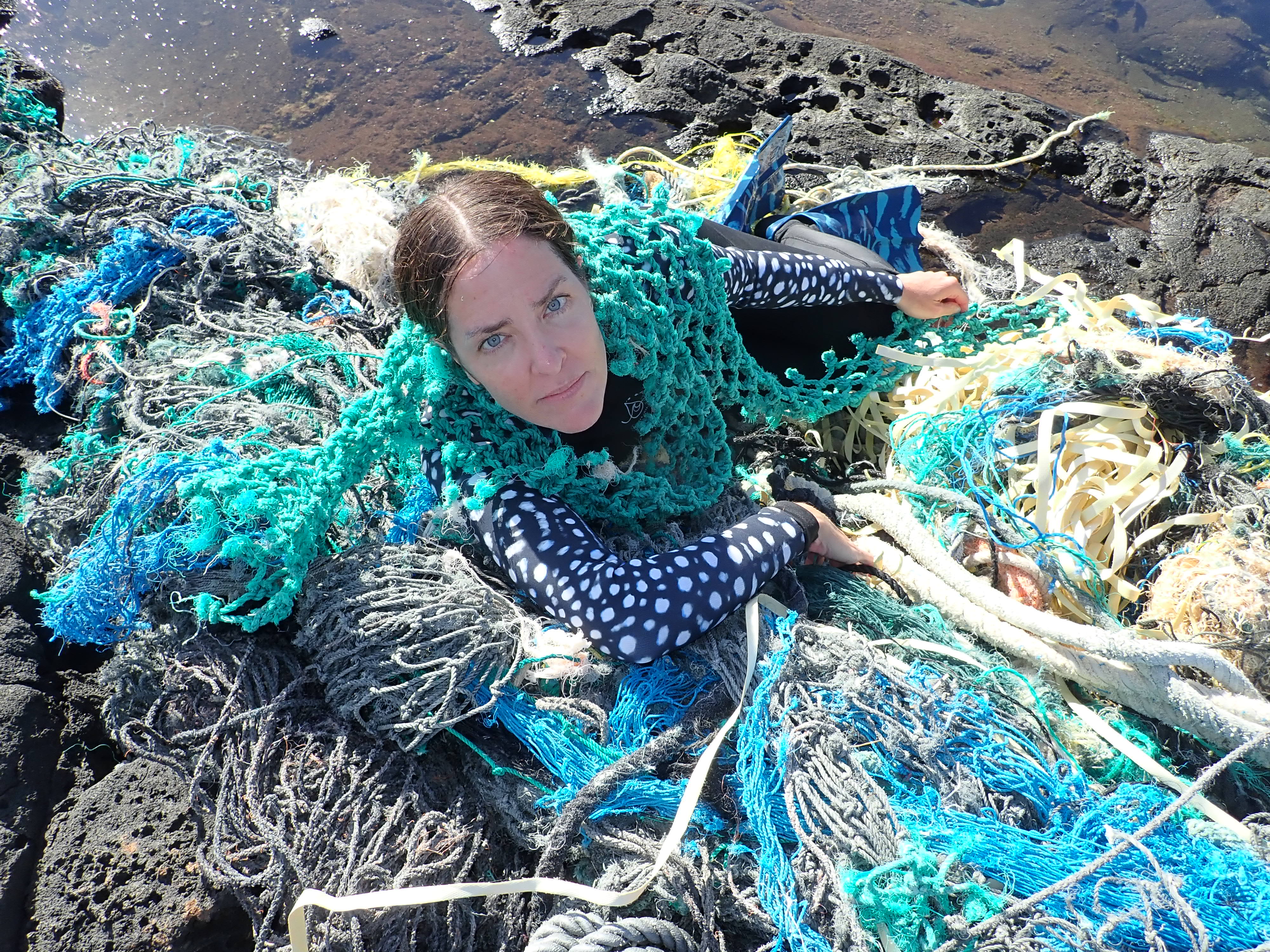Ocean Conservationists Retrieve 1,500+ Pounds of Debris
A couple was exploring the coastline of Lānaʻi by boat last week when they spotted a large mass of fishing net and plastic trash washed ashore on the remote volcanic tidepools near a spot called Nanahoa (Three Stone), known for its three large pinnacles.
The Hawaiian Islands had previously seen a few weeks of unprecedented storms, so the couple and their captain guessed the net had come ashore during some of this tumultuous weather.
After snorkeling to the spot and climbing to investigate, Sven Lindblad and Kristin Hettermann saw something up close that shocked them both—a mass of fishing net so dense that it could not be budged, with uncountable assortment of different types of fishing and cargo nets, buoys and other plastic trash. They estimated it to weigh 1,500 to 2,000 pounds and be about 30 feet in length.
Clearly not able to move this large piece of floating ocean trash, they continued their circumnavigation of the island but could not forget about what they had seen, according to a Feb. 26 press release.
“As inspired ocean conservationists, Sven and I are constantly exploring the world’s ocean, raising awareness for its challenges, encouraging behavior change and supporting organizations doing important ocean conservation work,” Hettermann said. “It just didn’t seem right to leave it there when we had the capacity and resources to do something about it.”
Lindblad and Hettermann reached out to Captain Jason Allen of Fish N Chips that evening for a quote to charter him again—but this time with local free diver Skylar Fisher. The group returned the next day to work together to reclaim the trash and take it to a place where it could be more easily and properly disposed of by the island’s services.
“We had no idea how this was going to work,” recounted Lindblad. “It was a very difficult task, and our first attempt was to try to hook it with a large metal marine grade hook and use the boat’s 500 HP engine to drag the net back into the sea. The hook immediately bent. When we were able to get line tied around the girth of the mass, the boat was powerful enough to drag it off the ledge and into the ocean.”
The group towed the mass back to the Manele Small Boat Harbor for two hours at a speed of 2 knots.
Sven and Kristin decided to undertake the challenge in hopes that their efforts would inspire others to do their part in cleaning up our ocean.
“Hopefully as we move to the future new materials will be made that can address human needs (sustenance, transport) and not last for decades in our natural systems,” Hettermann noted. “Even though what we saw was a lot of fishing net, the blame is not to rest on the fishermen just throwing their trash in the ocean. So much of our modern challenge rests in just cleaning up the remnants of the past – what was accepted and expected and somehow ended up in our natural system. Every little bit of trash that is removed from the ocean system helps as we hopefully move toward a more sustainable future for our planet.”
According to a report jointly produced by FAO and UNEP, fishing nets abandoned at sea remain in the marine ecosystem for hundreds of years, and can result in the accidental capture of dolphins, turtles and other marine animals, which can die trapped in the mesh. Not to mention the challenges they represent to boats when they get caught in engines. Known as ghost fishing nets, experts have estimated that there are roughly 640,000 tons of these nets currently in our ocean, accounting for 10 percent of the total plastic waste in the sea.
“If you imagine anyone with means—whether it be a boat, willing hands or monetary resources—viewing ocean trash as an obligation to act, citizens of all stripes could accomplish a lot to rid our oceans of this scourge,“ Lindblad said.
Lindblad, founder of Lindblad Expeditions, and his fiancé, Hettermann, founder of OCEANSCAPES, were enjoying the island of Lānaʻi celebrating their anniversary. They are based between Maui and New York and both active internationally in the ocean conservation arena. Lindblad is an Ocean Elder, a dedicated group of global leaders that use their collective influence to pursue the protection of the ocean’s habitat and wildlife. Hettermann is an artist, writer and underwater photographer.
Lānaʻi is the sixth-largest of the Hawaiian Islands and 97% owned by Larry Ellison (founder and chairman of Oracle), with the remaining 3% owned by the state of Hawai’i and privately-owned homes.
More information, contact Hettermann at (808) 205-4767 or [email protected].

PC: Sven Lindblad and Kristin Hettermann tidepool cleanup, Feb. 26, 2019

PC: Sven Lindblad and Kristin Hettermann tidepool cleanup, Feb. 26, 2019

PC: Sven Lindblad and Kristin Hettermann tidepool cleanup, Feb. 26, 2019

PC: Sven Lindblad and Kristin Hettermann tidepool cleanup, Feb. 26, 2019

PC: Sven Lindblad and Kristin Hettermann tidepool cleanup, Feb. 26, 2019

PC: Sven Lindblad and Kristin Hettermann tidepool cleanup, Feb. 26, 2019


















